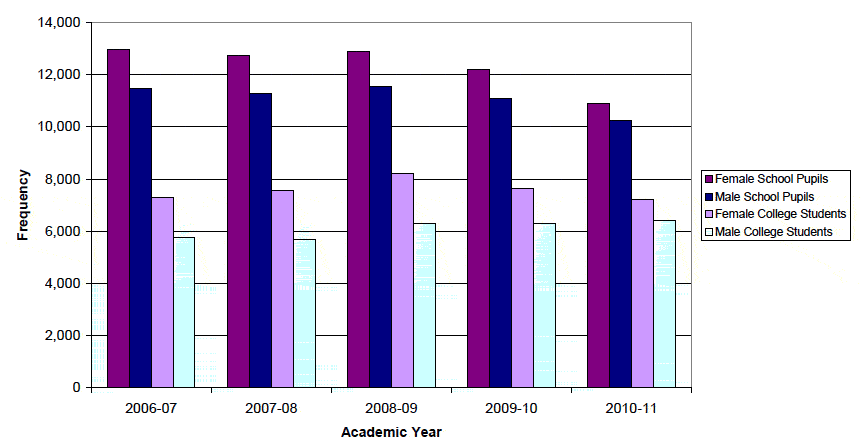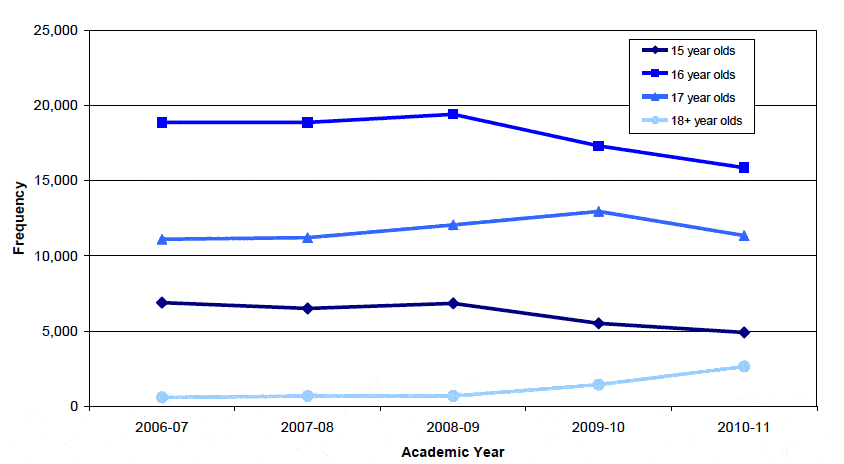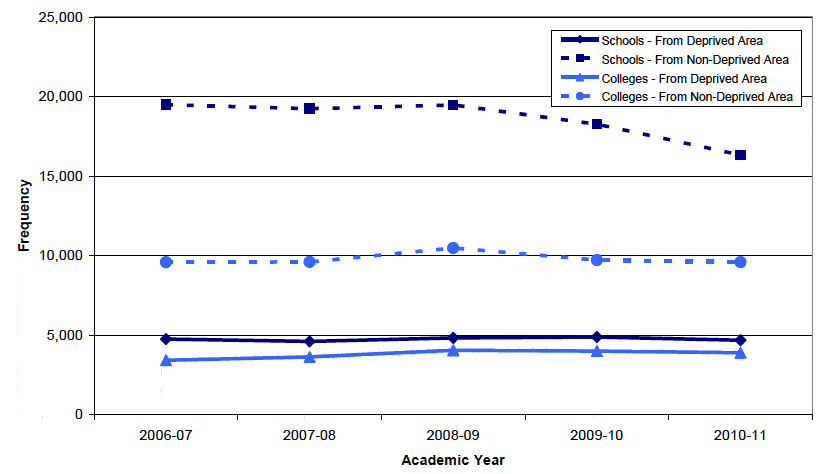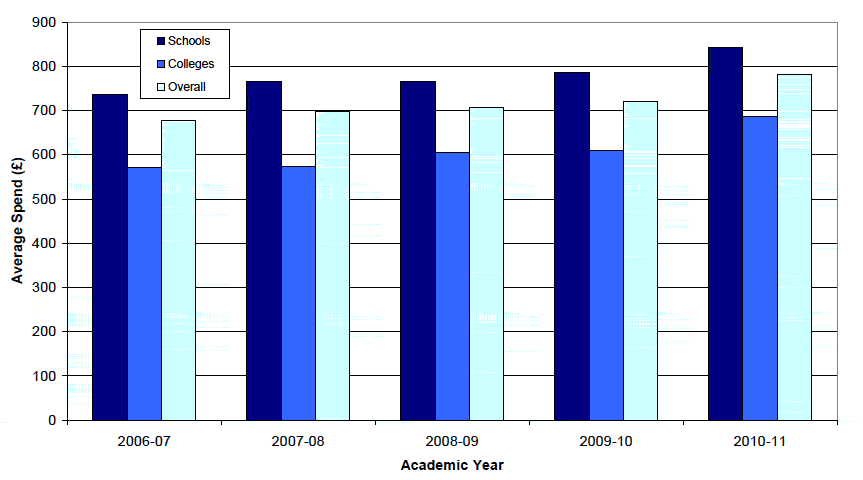Education Maintenance Allowances 2010-11
Statistics on Education Maintenance Allowances (EMAs) in the academic year 2010-11. This release contains information on all students at school or at a college in Scotland who received at least one payment under the EMA scheme. This is the fourth year of full roll out of EMAs.
Analysis and Interpretation
Recipients of EMA
In 2010-11 there were 34,780 young people who received EMA payments, a decrease of 6.6% (2,450) from 37,230 in 2009-10. The majority (61% or 21,120) of EMA recipients accessed the scheme while studying at a Scottish school, with the remaining 39% (13,660) attending a Scottish college (see table 1). Additionally, 48% (16,660) of EMA recipients during the 2010-11 academic year were male, compared to the 52% (18,115) that were female.
Of all school pupils in Scotland aged 16 to 19 years old, 32% (21,120) received an EMA payment in 2010-11 (see table 2).
Gender
Figure 1 below allows comparison between the number of male and females that received an EMA payment according to which type of institution they attended.
Figure 1: Young People in Receipt of EMA by Institution Type and Gender: 2006-07 to 2010-11

[See Table 1, page 10]
We can see from the chart above that the difference between the number of male and female EMA recipients has been gradually decreasing since 2008-09 for both school and college students. Additionally, from 2008-09 onwards the number of EMA recipients has decreased in all groups with the exception of male college students.
Age
Figure 2 shows a time series of the different age groups that receive EMA in schools and colleges.
Figure 2. Young People in Receipt of EMA by Age: 2006-07 to 2010-11

[see Table 2, page 10]
From the academic year 2006-07 to 2008-09 the level of EMA recipients of all ages remained fairly constant, with a slight increase in overall numbers throughout. From 2008-09 onwards however we can see differences in the pattern of EMA for each age group. The younger students in receipt of EMA have been falling in number in the last two years, with the number of 16 year olds falling by 18.3% (3,545) and the number of 15 year olds falling by 28.2% (1,935). This could possibly be explained by the removal of £10 and £20 a week payment levels implemented after the 2008-09 scheme. The only age group that has shown any increase is the 18 and 19 year old group, whose numbers have more than doubled between 2008-09 and 2010-11. This is mainly due to an increase in 18 and 19 year old college students receiving EMA.
Deprivation
The proportion of EMA recipients living in Scotland's 15% most deprived areas in 2010-11 (which contained 15% of 16 to 19 year olds in Scotland in 2010) was 24.7% (8,580), an increase of 0.8 percentage points since the previous year and 2.9 percentage points since 2006-07. The proportion of EMA recipients from the 15% most deprived areas in Scotland has increased every year since the 2006-07 scheme (table 2).
Figure 3 shows the difference in representation among EMA recipients of young people from the 15% most deprived areas in Scotland compared to those who are not.
Figure 3. Young People in Receipt of EMA by Institution Type and Deprivation Background: 2006-07 to 2010-11

[see table 3, page 11]
The chart above shows that the decreases in overall EMA numbers displayed in Table 1 are mainly attributed to school pupils who are not from a deprived area. Since 2008-09, the number of students in this category receiving EMA has fallen by 16.2% (3,155) from 19,470 to 16,315. One possible factor behind this trend could be the closure of the £10 and £20 weekly payment levels after the 2008-09 scheme. Since those who were in receipt of the £10 and £20 weekly payment levels would have had a higher family income than those who received the £30 weekly payments, we would expect that recipients from a non-deprived area would be more affected by this change than those from a deprived area.
EMA Spend
Total Spend
The total spend on EMAs in 2010-11 was £27.2 million. This has decreased from £33.2 million the previous year, though this is primarily due to the ending of bonus payments prior to the beginning of this year's scheme (for more information on this change please refer to the EMA background note on page 4). £6.4 million was paid out in bonuses as part of the 2009-10 scheme. The ending of the bonus payments had the largest impact on school pupils spend, which was down by £5.7 million, from £23.5 million in 2009-10 to £17.8 million in 2010-11. Overall spend for college students decreased slightly from £9.7 million to £9.4 million over the same period. The weekly payment figure for 2010-11 was £27.2 million compared with £26.8 million in 2009-10 (table 4 and table 5).
The £0.4 million increase in weekly spending from last year was driven by an increase in spend for college students (up £0.9 million from £8.5 million to £9.4 million); while spend for school pupils decreased over the same period (down £0.5 million from £18.3 million to £17.8 million). The proportion of EMA spend paid out to school pupils in 2010-11 was 66% compared to 71% in 2009-10 (table 5).
Average Spend (excluding bonus payments)
Figure 4 charts the development of the EMA scheme's average annual spend per person (student/pupil) in each of the last five academic years. Average EMA spend was calculated by dividing the total weekly payments paid out by the number of people who received an EMA payment each year. Weekly payments have been used instead of total spend to allow comparisons with previous years' data. This is because bonus payments ceased as of the 2010-11 EMA scheme (detailed in table 4 and 5).
Figure 4. Average EMA Spend (£) per Person by Institution Type: 2006-07 to 2010-11

[see table 5, page 12]
We can see from the above graph that the average EMA spent per person has risen every year since the 2006-07 academic year. This is the case for both school pupils and college students. The difference in average spend between 2006-07 and 2010-11 are summarised in the table below.
| Table A | 2006-07 | 2010-11 | Increase | ||||
|---|---|---|---|---|---|---|---|
| Number | Weekly Payments | Average Payment | Number | Weekly Payments | Average Payment | ||
| School | 24,430 | 17,975,080 | £736 | 21,120 | 17,805,960 | £843 | £107 |
| College | 13,050 | 7,455,005 | £571 | 13,660 | 9,371,260 | £686 | £115 |
| Total | 37,480 | 25,430,085 | £679 | 34,780 | 27,177,220 | £781 | £102 |
One explanation for these average increases is the previously noted closure of the £10 and £20 payment levels after the 2008-09 EMA scheme. Since the vast majority of students now receive the maximum £30 weekly payment, the average spend per person would be expected to be higher in the most recent academic years.
Contact
Email: Jeff Zinger
There is a problem
Thanks for your feedback